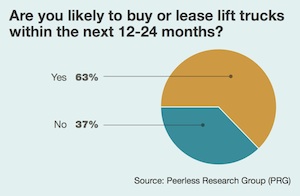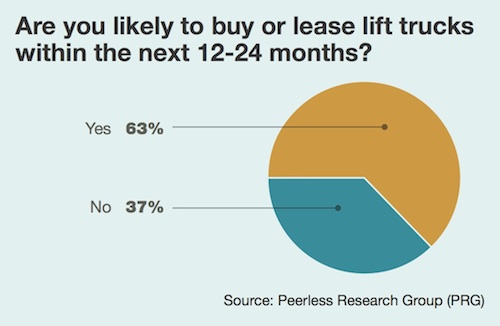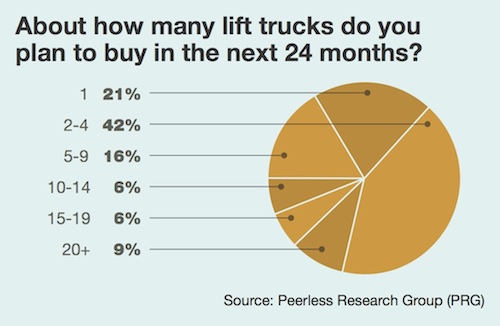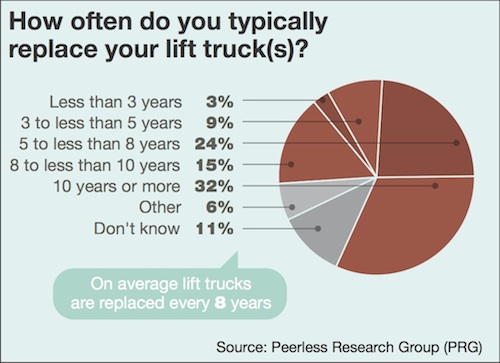Lift truck user survey: Readers report steady growth
Lift truck purchases remain steady in 2015 as companies look to upgrade or replace vehicles while also putting more into their training, technology and maintenance programs.

As the vehicles that companies rely on to move product around in today’s quick-response, omni-channel-focused warehouses and DCs, lift trucks play a critical role in the overall supply chain. With equipment buying trends fluctuating year over year and with uncertainty over the strength and longevity of the economic recovery keeping companies in “cautious but optimistic” mode, the lift truck sector continues to see steady increases in purchase commitments, lease transactions and the use of technology and metrics to work more efficiently.
Although spending on lift trucks is expected to be lower in 2015 (using 2014’s survey results as a basis), the outlook among Modern’s readers is largely positive across a number of different measures. For Modern’s annual “Lift Truck Acquisition & Usage Study,” conducted by Peerless Research Group (PRG) in June, we asked readers about the key aspects of lift truck procurement, operation and maintenance. In recent years, the survey has highlighted trends like the increasing dominance of electric lift trucks; the use of technology to track key performance, maintenance and metrics; leasing/buying trends; training and maintenance plans.

In 2015, the types of lift trucks in use at their facilities are:
• electric-powered rider trucks including counterbalanced, sit-down and stand-up types (63%);
• electric-powered pallet trucks including walkies, riders, low and high lift, and reach types (50%); and
• electric-powered narrow-aisle trucks including order-pickers, side-loaders, turret trucks, stackers and reach trucks (41%).
Other types of lift trucks in use include IC-powered counterbalanced lift trucks, electric and IC-powered rider-type tow tractors, and rough terrain lift trucks.
By the numbers
In 2015, nearly 20% of companies plan to spend $50,000 to $99,999 on lift trucks while 52% expect to allocate less than $50,000 to such purchases. An additional 14% will spend $100,000 to $249,999 and 8% will allocate $250,000 to $499,999. In 2014, 46% of companies spent less than $50,000, while 14% planned to spend more than $250,000.
Currently, the number of lift trucks in use at the typical facility ranges from three to nine (30%), 25 to 49 (15%), and less than three (17%). The average number of lift trucks in use is 23 per facility. One year ago, the average respondent operated a fleet of 24 lift trucks and planned to acquire an additional seven units over the coming two years. The bulk of companies planned to buy between five and 19 units while 9% said they were going to purchase more than 20 and 68% planned to acquire four or fewer lift trucks.

When asked if they were likely to buy or lease lift trucks within the next 12 to 24 months, 63% of companies said yes and 37% said no. The former is down compared to 2014, when 70% of respondents indicated that they were likely to buy or lease within the coming 12 to 24 months. According to the survey, the highest percentage of respondents (41%) plan to purchase two to four lift trucks, while 20% expect to buy one lift truck, and 16% will acquire between five and nine vehicles.
When it comes to replacing their lift trucks, 24% of companies do so within eight years of purchasing the vehicles, while 32% wait 10 years or more to make this move. Another 15% replace their vehicles within 10 years or less. The majority of companies (61.5%) buy their lift trucks, while 17% lease and 21.5% use a combination of both acquisition strategies.
When asked why they purchase their lift trucks, 39% said it’s a financial decision/for accounting purposes, 28% responded that they have low hour usage for their lift trucks, 28% said it’s what they’ve always done, and 25% said they get better ROI.
The practices used for lift truck rotation or disposal include reselling the lift trucks that are replaced (41%), the dealer taking older ones when the new lift trucks are delivered (39%), and companies holding onto/storing lift trucks that are replaced just in case they are needed at a later date (24%). Another 19.5% hold on to replaced lift trucks and then use them for parts.

Lease versus buy
According to the survey, 66% of companies do not operate a core fleet of lift trucks while another 34% have taken this route. When asked why they lease their lift trucks, 69% of companies cite flexibility (while reducing upfront investment) as their primary driver, followed by less maintenance costs/service being included in the lease (33%), corporate policy (28%), and the fact that it allows them to use their current technology (25%).
By comparison, in 2014 about 42% of respondents operated a “core” fleet of regularly used lift trucks in addition to a less-utilized reserve fleet. For those that buy their lift trucks outright, 30% said the dealer takes an older unit when a new one is dropped off.
Another 20% said they held onto old lift trucks for parts and more than 50% said they would resell the replaced lift trucks. When it comes to buying and leasing lift trucks, 87% do so based on the situation (sometimes lease/sometimes buy), 27% said it’s for cost/cash flow reasons, and 9% have a lease-to-buy program in place. These sentiments echo those of last year’s respondents, 24% of which said they buy lift trucks for the affordability factor.
When asked to what extent the economy or market conditions factor into their lift truck acquisition strategies, nearly 60% of respondents said such issues have little or no impact on the process while 21% said their purchase decisions are impacted to some extent, and another 19% said their purchase decisions are impacted to a great extent.
In 2014, 60% of readers indicated that the economy had little or no impact on how they acquire lift trucks, whereas 19% said the economy influences their decisions to some extent and 21% said it impacted such decisions to a great extent.
Making purchase decisions
To purchase their lift trucks, 82% of respondents buy directly from dealers and 22% purchase direct from manufacturers. And when expanding their fleets, 40% of companies are “somewhat likely” to evaluate manufacturers whose lift trucks they are not currently using, while 25% responded they’re “very likely” to do so.
When adding trucks, 17% of companies said they “aren’t very likely” to evaluate current providers, while another 12% are “extremely likely” to do so. These results are similar to those of 2014, when 23% were “very unlikely” or “not at all likely” to consider new suppliers.
When asked whether they use an approved vendor list or “short list” when buying lift trucks, 48% do and 52% do not. Last year, 53% worked with a short list. Also, in assessing whether they’ve had cause to remove a vendor from their “short list” in the last two years, 78% said no and 22% said yes (compared to 28% who said yes in 2014).
To service and maintain their lift trucks, 40% of companies outsource the task to their lift truck dealers, 37% rely on their in-house staff, and 22% outsource to maintenance/service contractors. After reviewing the types of lift truck parts that they’re likely to purchase in the next 12 months, 72.5% of companies said they’ll buy wheels and tires, 61% plan to acquire batteries and battery accessories, 47% expect to purchase tune-up parts, 43% plan to buy brake components, and 42% plan to acquire chemicals, lubricants and oil.
Training and software
To train their lift truck operators, 83% of readers rely on internal training programs while 15% turn to independent service providers, and 13% work with dealers. When asked whether they’ve adopted—or, if they’re planning to implement—technology to help with fleet management, 57% of companies responded no and 43% responded yes. The latter number ticked up slightly over 2014, when just 41% said they had adopted, or plan to adopt, such technology.
Survey respondents have mixed feelings about their fleet management software implementations, with 39.5% calling the process “somewhat successful” and 28% saying it was “very successful.” Another 16% called the implementations “extremely successful” and 12% don’t feel that their implementations were successful at all.
About the survey
Peerless Research Group (PRG) received a total of 205 qualified responses to this year’s survey. A qualified response was defined as an individual who was personally involved in the evaluation, selection, and/or procurement of lift trucks for their facility. Among the companies surveyed, 40.5% were manufacturers, 34% were DCs, and 17% were in warehousing. Primary products or services included food, beverage and tobacco (12%), fabricated metals (7%), industrial machinery (6.5%), and chemicals/pharmaceuticals (5%). Most of the companies employed less than 50 people (28%), while 19% had 50 to 99 workers, and 18% employed between 100 and 249 people. Their annual revenues ranged from less than $5 million (17.6%) to $5 billion or more (8.5%).
When tracking forklift data for maintenance, repair and replacement, 84% of companies (down from 86% in 2014) look at maintenance history, 78% (up from 65% last year) assess safety (including accidents, injuries, etc.), 73% (down from 75% last year) look at cost to maintain the equipment, and 64% consider truck age into the equation.

Article Topics
Latest in Materials Handling
Registration open for Pack Expo International 2024 Walmart chooses Swisslog AS/RS and software for third milk processing facility NetLogistik partners with Vuzix subsidiary Moviynt to offer mobility solutions for warehouses Materials Handling Robotics: The new world of heterogeneous robotic integration BSLBATT is looking for new distributors and resellers worldwide Lucas Watson appointed CSO for Körber’s Parcel Logistics business in North America Hyster recognizes Dealers of Distinction for 2023 More Materials HandlingAbout the Author
Subscribe to Materials Handling Magazine

Find out what the world's most innovative companies are doing to improve productivity in their plants and distribution centers.
Start your FREE subscription today.
April 2024 Modern Materials Handling

Latest Resources










